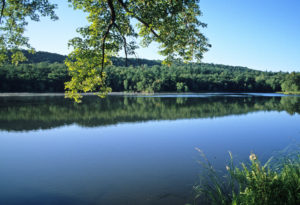By Robert Godfrey
Think about all the forests you ever enjoyed in your life. Their natural beauty, the wildlife that inhabit them, the

Sky and trees reflected in tranquil lake water within Flambeau River State Forest.
calming break they give us all from our hectic lives. Forests are important for a lot of reasons and serve a great many purposes. But have you ever stopped to think about all the things forests do to help our environment?
For example, forests are like lungs. They are critical in absorbing and storing carbon dioxide (CO2) from our atmosphere and helping us to fight climate change.
But have you ever thought of our forests as a water sponge?
It’s true. What they do is truly amazing. They collect and filter rainwater. Then they release it slowly into our streams and rivers. At the same time, these “forest sponges” – trees are made up of more than 50 percent water – are doing some purifying magic, taking out all kinds of pollutants from water before it reaches a stream or river.
In these forest environments, when the water flow is slowed by leaves and roots, sediments settle out of the water. The sediments can contain all kinds of toxic mixtures such as phosphorus and nitrogen, pesticides and herbicides, metals, oils and solvents – all harmful to our rivers, lakes – and our drinking water. They are trapped or converted before they enter our water supply. So, the more forests that we have, the lower the costs to treat our water.
Forests also increase our rainfall. When water evaporates from plant leaves, it moves into the atmosphere. This can expand cloud cover and increase rainfall over time. A healthy 100-foot-tall tree can take 11,000 gallons of water from the soil and release it into the air again, as oxygen and water vapor, in a single growing season. They “drink” in the water using their small, hair-like roots. Water from the soil enters their roots and is carried up the tree’s trunk all the way to the leaves.
And when it does rain, forests help to absorb that water, preventing erosion and flooding. A mature tree can typically absorb up to 30-40% of the rainfall it encounters. Forests also shelter lots of vegetation and provide a home for all sorts of forest creatures. It’s fitting that the International Day of Forests (on March 21) and World Water Day (on March 22) fall next to each other, as the health of these important resources often go hand-in-hand.
Urban forests – the trees in cities, the places we work and live – are also incredibly important for the quality of the water we drink and the air we breathe. The water-resistant surfaces, such as a streets and parking lots found across our cities, can produce 27,000 gallons of storm water when one inch of rainfall falls on pavement. To contrast, the average American uses an estimated 80 to 100 gallons of water per day, so protecting water quality in urban areas is extremely critical.
When trees are planted in and around parking lots and streets, they can have a big effect on water quality. They can reduce storm water runoff because it decreases peak water flows during rainstorms. This will then reduce the damage to our rivers and streams. Large increases in the amount of storm water volume that reaches streams can cause major erosion problems, flooding, increases in nutrients and sediment, and damage aquatic habitats. In urban and suburban settings, a single common tree can intercept from 500 to 760 gallons of storm water per year; and a mature evergreen can capture and filter more than 4,000 gallons per year. Even young, small trees help to reduce storm water runoff.
Another remarkable fact: A single mature oak tree can consume over 40,000 gallons of water in a year and release much of it into our atmosphere as oxygen and water vapor.
With proper planning, urban street trees can grow to their full size and live for many decades. They can improve the beauty, privacy, and a sense of place, even in the most challenging of urban environments. These tree canopies can improve the air quality of a neighborhood by absorbing pollutants, dust, smoke, and pollen. They can also increase oxygen levels, while reducing carbon dioxide (CO2) – a major driver of climate change. They save energy by providing shade and cool the air as moisture escapes from their leaves. Trees in cities can even reduce crime and improve perceptions of business districts.
In addition to all these benefits, trees reduce our environmental management costs for things like storm water treatment, saving us all money.
Learn more about Wisconsin’s urban forest resource here.
#NASF100
